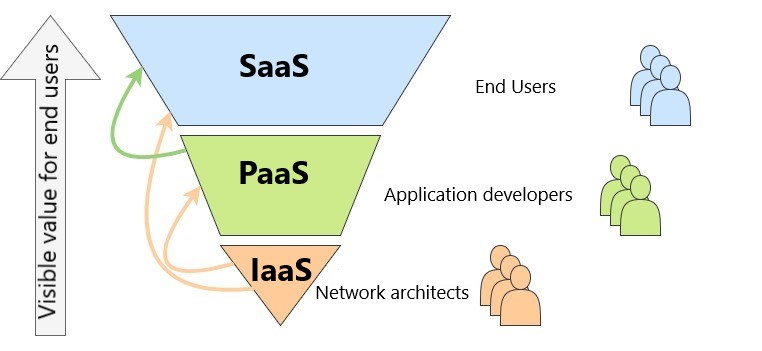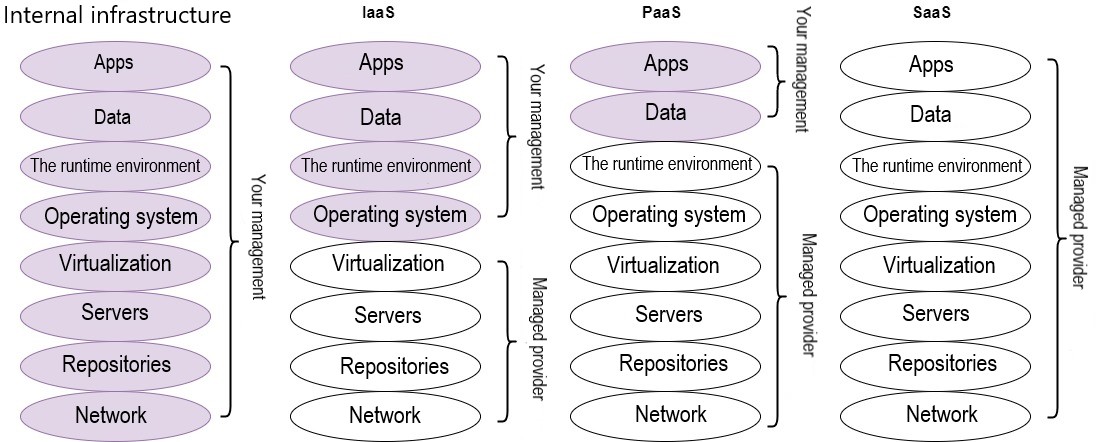Abstract
Content
- Introduction
- 1. Formulation of the problem
- 2. Relevance of the topic
- 2.1 Basic characteristics of cloud computing
- 2.2 Location of applications
- 2.3 Provided services
- 2.4 Limits of controllability
- 2.5 Existing Cloud Platforms
- 2.6 Advantages and disadvantages of "cloud" technologies
- 3. Network traffic in data centers.
- Conclusion
- References
Introduction
In the modern world of information technology, "cloud" environments have been used for a long time: both on the Internet and in various enterprises. The potential for technology that can scale freely allows not only the use of direct information products, but also expand the limits of administration and maintenance of user data, their processing and use by own means in the field of "cloud" technologies.
1. Formulation of the problem
The essence of "cloud" technologies is the provision to the end user of remote dynamic access to computing resources, services, and applications (including information and operating systems, server software, etc.) via the Internet or through a corporate network. The trend of hosting development and the need for most people to use public resources was determined by the emerging need for new software and digital information services that could be managed from within, but which would be more economical and efficient.
The goal of the work is to increase the efficiency of the data processing centers providing cloud computing services. [1]
To achieve the goal it is necessary to solve the following tasks:
1) Analysis of modern "cloud" technologies;
2) Analysis of traffic in the data center;
3) Modeling traffic in the data center.
2. Relevance of the topic
"Cloud" technology is an information and technology model that provides convenient on-demand network access from any place where there is Internet access to a variety of configurable computing resources (data networks, servers, storage devices, applications and services-both together, both individually and separately) that can be provided in a timely manner with minimal costs or calls to the provider. The term "cloud" should be understood as the organization of network access to a remote data center with payment for actual consumption of computing resources (PAYG - Pay As You Go).
2.1 Basic characteristics of "cloud" computing
The National Institute of Standards and Technology (NIST) in its document "The NIST Definition of Cloud Computing" defines the following characteristics of the "clouds":
— the possibility of a highly automated self-service system on the part of the provider;
— availability of Broad Network Access (access to the network from a wide range of devices);
— concentration of resources on individual sites for their efficient distribution;
— rapid scalability (resources can be unlimitedly allocated and released at high speed depending on needs);
— managed service (cloud management system automatically monitors and optimizes allocation of resources).[2]
2.2 Location of applications
Currently, there are three main models for the location of applications:
— in the infrastructure of the customer;
— the hosting company;
— in the "cloud".[3]
2.3 Provided services
There are three basic models of working with the "cloud":
1) Infrastructure as a Service - means that instead of purchasing physical server equipment, the user gets the necessary IT infrastructure specifically for his needs for rent, and pays only the actual consumption of resources.
2) Software as a Service - provides the user with the opportunity to rent expensive software with a fixed fee. This model is the most widespread to date model of providing cloud services.
3) Platform as a Service - allows to use the computing platform as a service with the ability to deploy and support web applications and various services without their purchase. This concept is focused mainly on developers.

Figure 1 - Basic models of working with the "cloud"
2.4 Limits of controllability
When considering the different types of cloud services, you should pay attention to the boundaries of controllability - something that is directly controlled by the customer, and that - by the supplier company.

Figure 2 – Limits of controllability
2.5 Existing Cloud Platforms
1) iCloud
"Cloud" service iCloud from Apple (which came to replace MobileMe), fully automatic and free (albeit with small functional limitations). It allows you to store all kinds of content (mail, calendar, contacts, documents, music, videos and images, etc.) on servers, and then delivers it to all devices (iPhone, iPad, iPod touch, Mac and PC) Push Technology.
2)Google Play
"Cloud" service called Google Play from Google is designed to accommodate users of movies, music, applications and books on special servers for storing digital information. Access to the service is provided directly from the browser, regardless of the OS, and therefore can be carried out from both PCs and mobile devices based on Android. Each user has the opportunity to post and store up to 20,000 music records on a free basis, and also directly download to the server purchased in stores (Android Market, Google Music and Google eBookstore) digital goods - movies, e-books, programs, music tracks , both purchased and rented.
3)Xbox Live
Game service, which also provides rich Internet functionality and has to do with "cloud" technologies. The essence of the service is that the owners of Xbox 360 game consoles and Windows Phone 7-based PDAs can play with each other in computer games and communicate, and also buy add-ons and various multimedia content in the online store. Thus, the service creates a kind of virtual universe for gamers, the components of which are not located on consoles of end users, but in the "cloud".
2.6 Advantages and disadvantages of "cloud" technologies
Advantages:
— access to personal information from any computer connected to the Internet;
— you can work with information from different devices (PCs, tablets, phones, etc.);
— work with any operating system;
— one and the same information can be viewed and edited simultaneously from different devices;
— many paid programs have become free (or cheaper) web applications;
— backup copies of any information of any device;
— always updated programs;
— you can combine your information with other users;
— it is easy to share information with anyone, wherever they are.
Disadvantages:
— to access the services of the "cloud" you need a permanent Internet connection;
— the confidentiality of data stored in public clouds is currently very controversial, but in most cases experts agree that it is not recommended to store the documents most valuable to the company on a public cloud, since there is currently no technology which would guarantee 100% confidentiality of the data;
— "cloud" in itself is a fairly reliable system, but when it penetrates into it an attacker gets access to a huge data store;
— to build your own "cloud" it is necessary to allocate significant material resources, which is not beneficial to newly created and small companies.[4]
3. Network traffic in data centers.
At its core, the "cloud" is located on physical equipment, which is a data center. Thus, cloud service providers use data centers to host "cloud" services and "cloud" resources. Moreover, they often own several data centers in several geographic locations - so they ensure that the client will have access to their data during power outages and other malfunctions in the operation of some of the data centers.[5]
Network traffic - the amount of information transmitted through a computer network for a certain period of time.
Types of traffic:
— incoming: information coming from an external network to another network, computer, server, etc.
— outgoing: information coming to the external network;
— internal: movement of information within a certain network or part of the network, limited by some kind of feature (for example, inside the provider's network);
— external: information that flows outside a certain network, most often Internet traffic.
Network traffic can be measured in packets, bits (Kilobits, Megabites, Gigabits), bytes (Kilobytes, Megabytes, Gigabytes).

Figure 3 - Passing packets in the network
(animation: 7 frames, 149 kilobytes)
Data centers are in demand by government agencies, large organizations, such as banks, insurance and trade corporations, extractive industries, telecommunications companies (billing systems, hosting, all sorts of Web services and social services). All of them use complex business applications, and their activities depend on the reliability of the functioning of the IT infrastructure. The main problem is how, in a situation of constant increase in the cost of resources, to maximize the return on their operation. This raises key questions that need to be addressed when implementing a data center - how to achieve an increase in key indicators (performance, reliability, etc.) while minimizing costs (power consumption, administration), take into account possible load growth, provide recovery from failures and high availability especially important applications and services.
Conclusion
Thus, it is important to develop methods and models for improving the efficiency of providing information services in data centers.
This master's work is not completed yet. Final completion: june 2018. The full text of the work and materials on the topic can be obtained from the author or his head after this date.
References
- P.Mell, T.Grance. The NIST Definition of Cloud Computing. Recommendations of the National Institute of Standards and Technology, 2011, sp. 800-145.
- Кухаренко А.А. Облачные вычисления. Платформа Windows Azure: реферат / Кухаренко А.А. – Гомель, 2012. — 59 с.
- Батура Т.В., Мурзин Ф.А., Семич Д.Ф. Облачные технологии: основные понятия, задачи и тенденции развития // ЭЛЕКТРОННЫЙ НАУЧНЫЙ ЖУРНАЛ:ПРОГРАММНЫЕ ПРОДУКТЫ, СИСТЕМЫ И АЛГОРИТМЫ – 2014. doi: 10.15827/2311-6749.10.141
- Воробьёв Андрей Игоревич Модели и методы повышения эффективности предоставления информационных услуг в центрах обработки данных: дис. на соиск. учен. степ. канд. техн. наук: 24.13.01: защищена 24.01.12 / Воробьёв Андрей Игоревич. — Санкт-Петербург, 2012. — 144 с.
- Яремко І.М. Імовірнісні характеристики центрів обробки даних і резервування / І.М. Яремко, В.В. Турупалов, І.О. Молоковский // Наукові праці інституту проблем модулювання в енергетиці ім. Г.Є. Пухова "Моделювання та інформаційні технології". – Київ, 2011 р. - Випуск 60. – C.141-146.
